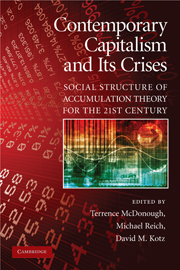Book contents
- Frontmatter
- Contents
- List of Tables
- List of Figures
- List of Contributors
- Acknowledgments
- Introduction: Social Structure of Accumulation Theory for the 21st Century
- PART I THE THEORY OF SOCIAL STRUCTURES OF ACCUMULATION
- PART II GLOBALIZATION AND THE CONTEMPORARY SOCIAL STRUCTURE OF ACCUMULATION
- 4 Global Neoliberalism and the Contemporary Social Structure of Accumulation
- 5 Globalization or Spatialization? The Worldwide Spatial Restructuring of the Labor Process
- 6 Financialization in the Contemporary Social Structure of Accumulation
- 7 Global Neoliberalism and the Possibility of Transnational State Structures
- PART III THE CONTEMPORARY SOCIAL STRUCTURE OF ACCUMULATION IN THE UNITED STATES
- PART IV SOCIAL STRUCTURE OF ACCUMULATION THEORY AND TRANSFORMATIONS OF THE CAPITALIST PERIPHERY
- Index
- References
5 - Globalization or Spatialization? The Worldwide Spatial Restructuring of the Labor Process
Published online by Cambridge University Press: 05 June 2012
- Frontmatter
- Contents
- List of Tables
- List of Figures
- List of Contributors
- Acknowledgments
- Introduction: Social Structure of Accumulation Theory for the 21st Century
- PART I THE THEORY OF SOCIAL STRUCTURES OF ACCUMULATION
- PART II GLOBALIZATION AND THE CONTEMPORARY SOCIAL STRUCTURE OF ACCUMULATION
- 4 Global Neoliberalism and the Contemporary Social Structure of Accumulation
- 5 Globalization or Spatialization? The Worldwide Spatial Restructuring of the Labor Process
- 6 Financialization in the Contemporary Social Structure of Accumulation
- 7 Global Neoliberalism and the Possibility of Transnational State Structures
- PART III THE CONTEMPORARY SOCIAL STRUCTURE OF ACCUMULATION IN THE UNITED STATES
- PART IV SOCIAL STRUCTURE OF ACCUMULATION THEORY AND TRANSFORMATIONS OF THE CAPITALIST PERIPHERY
- Index
- References
Summary
Introduction
Since the 1990s, scholarly accounts of globalization and its consequences have become prevalent throughout the social sciences (see Brady et al. 2007 for a review). While some view globalization as a centuries-long process of world system integration (Sklair 2002), others focus on recent changes in the last several decades. Although conceptualizations of globalization vary widely, they share a common insight that many phenomena previously centered in the local, sub-national, or national levels are increasingly interconnected on a global scale. Globalization implies increasing interpenetration and interdependency among societies, cultures, and peoples of the world often accompanied with a concern that the autonomy and sovereignty of the local setting is being diminished.
The changes created by globalization resemble the transformations discussed by those who advance social structures of accumulation (SSA) theory. Various scholars in this tradition place primary emphasis on the emergence of finance capital, neoliberalism, or other manifestations of globalization as the primary face of the new SSA. While having made numerous advances in SSA theory (Kotz, McDonough, and Reich 1994), we contend that SSA scholarship has strayed from Gordon, Edwards, and Reich's ([GER] 1982) central premise that the transformation of the labor process is a defining feature of each SSA (Wallace and Brady 2001). With the aim of restoring the centrality of the labor process, we extend the SSA approach in three ways.
- Type
- Chapter
- Information
- Contemporary Capitalism and its CrisesSocial Structure of Accumulation Theory for the 21st Century, pp. 121 - 144Publisher: Cambridge University PressPrint publication year: 2010
References
- 11
- Cited by



